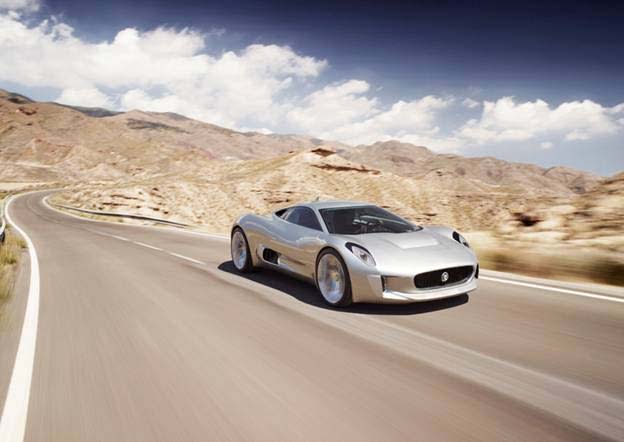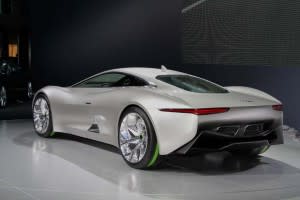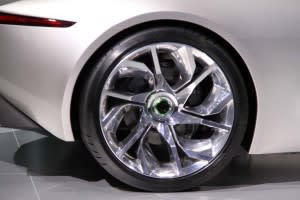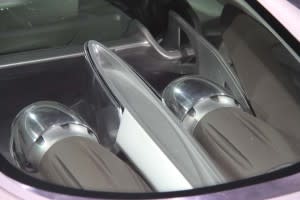Jaguar Will Build 200 mph C-X75 Battery Supercar
"Green" supercar will get 30 miles on battery power.
Bowing to strong public pressure, Jaguar has announced plans to put the well-received C-X75 supercar into production.
The striking two-seater will use an extended-range electric drive system capable of running entirely on batteries – yet also able to launch from zero to 60 in less than 3 seconds and reach speeds in excess of 200 mph. But the maker has opted to go for a relatively conventional gasoline “extender” engine, rather than the futuristic twin turbine system that drove the original C-X75 concept vehicle.
MORE AT THEDEtroitBureau.COM
“People expect Jaguar to be innovators – that is when Jaguar is at its best,” said Adrian Hallmark, Jaguar Brand Director, who only last month told TheDetroitBureau.com that the British maker was hesitant to make the investment in a new supercar while it was pushing to launch more mainstream products such as a new entry-level luxury car to replace its old X-Type.
But it appears Jaguar simply was overwhelmed by public reaction to the concept, first shown at last autumn’s Paris Motor Show.
“The C-X75 received an incredible reception as a concept car,” said Hallmark. “We’ve been building on that momentum and there is a clear business case for this exclusive halo model. No other vehicle will better signify Jaguar’s renewed confidence and excellence in technological innovation than this.”
With the approval of the new supercar project, Jaguar and sibling brand Land Rover will now have 41 “major” projects on the books, including all-new models – including the small car and a new Jaguar crossover – product variants and powertrain and other high-technology efforts.
To ease the engineering strain, Jag is partnering on the C-X75 with racing team Williams F1, which will lend its abilities in carbon fibre, aerodynamics and hybrid projects.
“Williams has always considered itself an engineering company and so this project will allow us to combine our technical expertise to create something truly exceptional,” said Sir Frank Williams, Chairman of Williams F1.
How close the final production car resembles the concept vehicle remains to be seen. In terms of basic specifics, however, Jaguar is aiming to match the outline it presented in Paris, which means the ability to run up to around 30 miles on pure battery power, while offering enough power in reserve to propel the C-X75 to a top speed “in excess of” 200 mph. The maker is promising “sub-three-second” zero to 60 times, and zero to 100 mph in 6 seconds.
When the batteries run down, the vehicle will automatically fire up what Jaguar officials are describing as a “state-of-the-art, small-capacity, highly-boosted internal combustion engine.” That is the most notable change from the show car, at this point.
The Paris prototype relied on twin micro-turbines, technology that could conceivably produce huge amounts of power on very little fuel. But Hallmark told TheDetroitBureau.com that turbines simply weren’t ready for real world automotive use. One of the problems is that they produce so much heat in their exhaust they could melt pavement or fry to plastic fascia of a vehicle too close behind.
Nonetheless, Jaguar believes it can come close enough to matching the performance of the turbines with a high-tech IC engine that will produce, on average, just 99 grams of CO2 per kilometer, on a par with some of the cleanest small cars on the road today.
“The engine’s compact size allows it to be mounted low in the car for optimum weight distribution and to retain the concept’s stunning silhouette. This will make the Jaguar C-X75 a bona fide hybrid supercar capable of silent electric running with an extensive EV range in excess of 50km,” explained Bob Joyce, Group Engineering Director, Jaguar Land Rover.
Even working with relatively familiar internal combustion technology doesn’t resolve all the challenges Jaguar and Williams face. The electric drive system will come in the form of four wheel-mounted motors, a promising but quite advanced approach that, among other things, raises issues with unsprung mass.
The Brits are promising to have the Jaguar C-X75 into production in a normal development cycle, which would suggest a launch around 2014, though that detail wasn’t released during a U.K. news conferences.
Jaguar did reveal that only 250 of the supercars will be built, and they will carry a price tag of 700,000 pounds, which would mean somewhere between $1 million to $1.5 million depending on where exchange rates go over the next few years.

 Yahoo Autos
Yahoo Autos 



